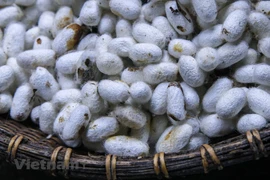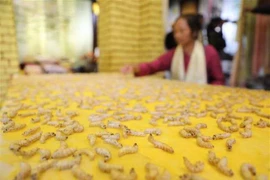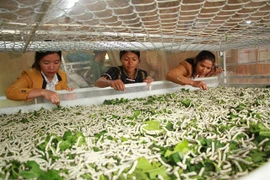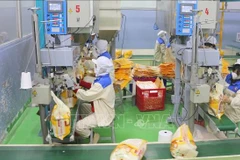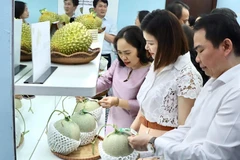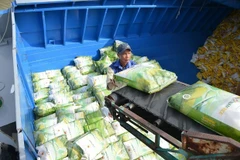 A farmer tends to a mulberry field in Da Teh district, the Central Highlands province of Lam Dong (Photo: baolamdong.vn)
A farmer tends to a mulberry field in Da Teh district, the Central Highlands province of Lam Dong (Photo: baolamdong.vn) HCM City (VNS/VNA) - Experts haverecommended the use of high-yield silkworm varieties thatcan adapt to Vietnamese conditions to reduce reliance onimports from China and other countries.
The Central Centre for Silk Mulberry Research has asked theMinistry of Agriculture and Rural Development for approval to implement aresearch project on mulberry silkworm breeding in the 2021-25 period.
Dang Vinh Tho, Chairman of the Vietnam Mulberry Association, said: “Theindustry will not have enough raw materials for manufacturing in the next 10-15years unless the country develops a sustainable strategy.”
“Despite the increase in silk production every year, Vietnam has to importthousands of tonnes of silk from China and Brazil for outsourcing work herewhich is exported to Japan, Italy, India and France.”
Under the project, the research centre and the Lam Dong Centre forExperimental Agriculture and Forestry Research will examine high-yieldsilkworm varieties with good cocoon quality.
Vietnam’s mulberry silk industry has relied too much on silkworm breedingimports, especially from China, according to the Department of LivestockHusbandry under the Ministry of Agriculture and Rural Development.
The country imports 90 percent of silkworm egg breeds from China throughunofficial channels, but imports have faced challengessince the outbreak of Covid-19 in China.
The imports through unofficial channels have not been checked for qualityand disease control, posing risks for producers.
In the last two years, Lam Dong, Dak Nong, Dak Lak and Gia Lai provinceshave developed 10,000 hectares of mulberry trees whose leaves are fed tosilkworms.
In Lam Dong province, some 15,000 households are cultivating about 8,500hectares of mulberry trees, but the province has to import about 500,000 boxesof silkworm eggs per year from China.
Tho has recommended that the Ministry of Agriculture and RuralDevelopment work with China to import silkworm eggs through officialchannels to ensure the quality of silkworm eggs.
He said the Ministry of Agriculture and Rural Development andthe Ministry of Industry and Trade should take measures toprevent trade fraud and unidentified silk imports.
The industry is facing severe competition from countries such as China,according to the Department of Agricultural Product Processing and MarketDevelopment.
Experts said the industry should improve productivity, reduce costs,increase technology use, diversify products, and help enterprisesbuild brands for Vietnamese silk.
Phung Duc Tien, Deputy Minister of Agriculture and Rural Development, said Vietnam’ssilk production ranks among the top five in the world, behind China, India,Uzbekistan and Thailand.
Last year, silkworm production reached nearly 9,200 tonnes, silk productionmore than 1,500 tonnes, and silk over 5.2 million metres.
According to the Vietnam Mulberry Association, there are 32 provinces andcities nationwide planting mulberry trees, with an area of about 15,000 ha.
Lam Dong province in the Central Highlands region has more than 8,500 ha andaccounts for 73 percent of the country’s silk production. Theprovince has developed a mulberry tree ecosystem thatincludes silkworm raising, silk germination and silk weaving./.


